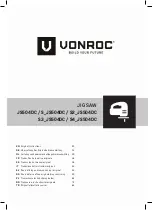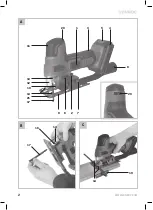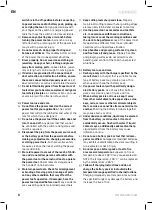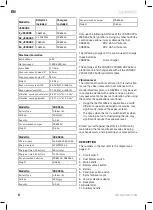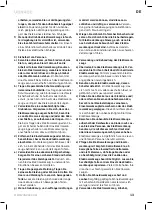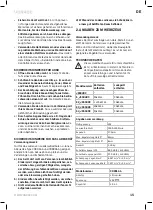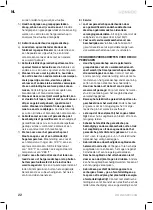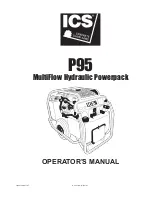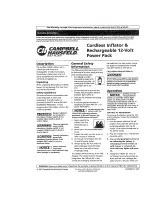
10
EN
WWW.VONROC.COM
teeth are pointing in the cutting direction.
3. Let go of the clamping lever. Check whether
the back of the saw blade is positioned in the
centre of the guide roller (10).
Make sure to use the right sawblade for the corres-
ponding material. Included with the machine is a
coarse sawblade for wood and a fine sawblade for
metal and plastics.
Removing the saw blade
1. Turn the clamping lever (13) as far to the left as
possible and hold it in this position.
2. Remove the saw blade from the chuck (16).
3. Let go of the clamping lever.
Attaching the parallel guide (Fig. C)
1. Loosen the wing bolts (14).
2. Mount the parallel guide (19) onto the baseplate
(9).
3. Set the desired cutting width using the scale
on the parallel guide (19) and the cutting mark
on the baseplate (21). The cutting mark (21)
indicates the position of the saw blade.
4. Tighten the wing bolt (14).
4. OPERATION
Switching the machine on/off (Fig. A)
• To switch the machine on, push the switch
forward and press the On/off switch (1).
• To switch the machine off, release the On/off
switch (1).
Setting the speed (Fig. A)
The speed adjustment wheel (20) is used for set-
ting the speed. The ideal speed depends on
the profile and the teeth of the saw blade and on
the material to be worked.
Do not set the speed during use.
Turn the speed adjustment wheel (20) to the requi-
red position.
• For hard materials, use a saw blade with fine
teeth and select a lower speed.
• For soft materials, use a saw blade with coarse
teeth and select a higher speed..
Adjusting the bevel angle (Fig. A, D)
1. Loosen the bolt (18), using the hex key (15).
2. Adjust the baseplate (9) to the desired position
(0°- 45°). The sawing angle (bevel) can be read
on the scale (7).
3. Tighten the bolt (18), using the hex key (15).
Adjusting the pendulum action (Fig. A)
The pendulum action switch (6) is used to set the way
in which the teeth of the saw blade grip the material.
The pendulum action switch can be set to 4 positions:
0 - No pendulum action
1 - Small pendulum action
2 - Medium pendulum action
3 - Large pendulum action
The required pendulum action can be determined by
practical testing, although the following instructions
can be observed:
• Soft material (wood, plastics etc.): set the pen-
dulum to level II or III. For a finer and cleaner saw
cut, use pendulum level 0 or I.
• Thin material, use pendulum level 0.
• Hard material (steel etc.): set the pendulum to
level 0.
• Curves: set pendulum to level 0.
Plunge cutting (Fig. H)
Plunge cutting may only be used on soft materials
such as wood, aerated concrete, gypsum plaster
boards, etc. However, this requires a certain practise
and is only possible with short saw blades.
1. Place the saw onto the workpiece and switch it on.
2. Ensure that the bottom edge of the footplate rests
on the workpiece surface as shown on Fig. H.
3. Slowly saw into the workpiece at an angle, mo-
ving the saw to a vertical position and continue
to saw along the cutting line.
4. Switch the saw off and lift off the workpiece
when the work is complete.
Dust extraction (Fig. E)
• Insert the vacuum cleaner adapter (8) into the
dust extraction connection.
• Connect the hose of a vacuum cleaner to the
vacuum cleaner adapter (8).
Note:
the dust blow function must be deactivated
when using a vacuum cleaner.

